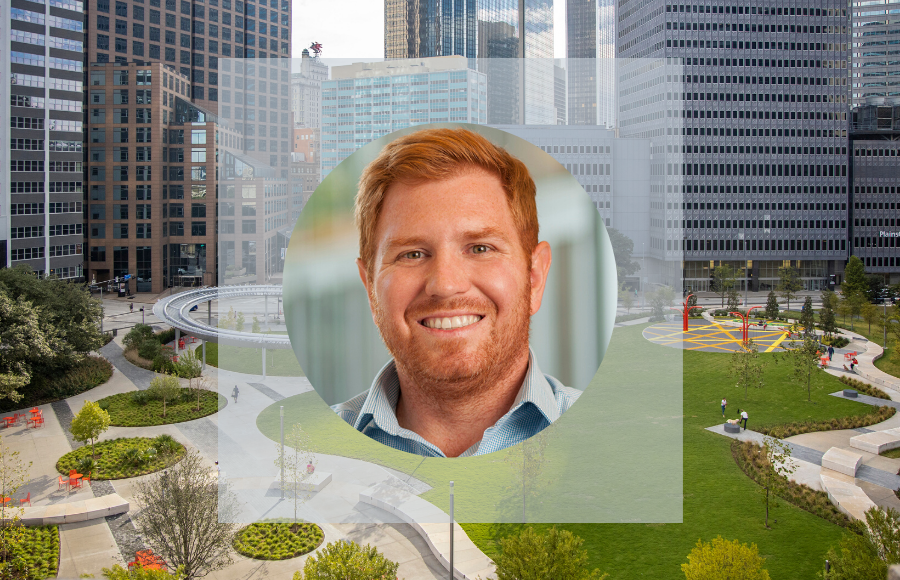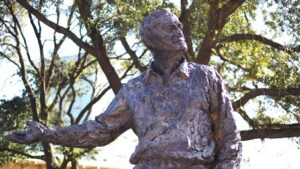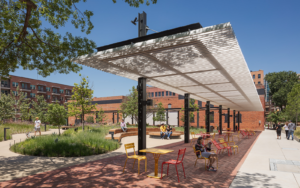In 2007, Project Manager Jim Shipley joined the Beck Group, a commercial structure and architecture company based in Dallas. In the years since, he’s managed a number of exciting projects throughout Texas, most recently completing work on Pacific Plaza. Now, he will turn his attention to West End Square.
We caught up with Jim to learn more about what it’s like taking a city park from start to finish and his hopes for the future of Downtown Dallas.
Tell us more about your background. What brought you to the Beck Group and what notable projects have you worked on in your career?
I started working for Beck in 2007. I had a few offers from different companies in the Midwest, but I wanted to take a chance on a new city and new adventures, and Beck was a really high-regarded company. In the past 12 years, I’ve been pretty fortunate to work on a lot of great projects and their different aspects, like mechanical and electrical, structures, exteriors and interiors, which has really helped me grow as a project manager.
I started with our AT&T group, where we do all of AT&T’s capital improvement projects in Texas, so I had dozens of projects, from data center expansions to fire alarm life safety upgrades to central plant expansions.
Since then, I’ve worked on Texas Health Harris Methodist Hospital, the Rory Meyers Children’s Adventure Garden at the Dallas Arboretum, UT Dallas Bioengineering and Sciences Building, 4510 on Main and the Tasset Eye Park renovation, JP Morgan Chase campus at Legacy West and, most recently, Pacific Plaza.
Tell us about the project manager’s role, from when you walk onto the site for the first time to the completion of the project.
In the simplest of terms, the project manager’s job is to make sure our superintendents and field supervision staff have what they need when they need it. So much of the work we put in place is from many different vendors, contractors and suppliers, and it’s the project manager’s job to make sure all those parts and pieces have been coordinated to fit together and comply with the architect’s design and the project schedule.
But really, the project manager’s job starts well before we ever walk on-site. We start early on with the pre-construction estimating team, and the superintendents develop project budgets, logistics plans and everything else needed to make the project successful. By the time we get on-site, we’ve been working on the project for months, laying the groundwork.
Closing the job is the hardest thing to do, but it’s like anything else—you turn the keys over to the owner. You make sure the project is complete, do final inspections, get your certificate of occupancy from the city and train the staff on how to operate the building or park. There’s a lot that goes into it.
You were the lead project manager on our first park, Pacific Plaza. How did you approach it, knowing you’d be creating a park from a parking lot?
The parking lot part was really easy. It’s just asphalt and concrete. Everything else underneath that and around that—that was the challenge. Pacific Plaza was what we call “curb to curb,” meaning we develop the entire site, so there’s not much room for storage and materials, and access can be difficult. Staging all of that was planned well in-advance so as not to block ourselves in.
Early on, we planned a phasing-in sequence of construction to create a flow. There would be some areas of the park that looked almost finished, while others were still in the mud, but in a park of that size, you can’t finish everything at once, so there needs to be some sort of sequence. There was also a lot of underground utility infrastructure we added for drainage and water fountains and sanitary sewers, so for a while there it didn’t look like we were doing much, but it was all part of the plan.
Live Oak Street was removed during the project, and that was probably one of the more difficult aspects just because we didn’t have as much control. There was a lot of existing telecommunication infrastructure under Live Oak as well, so we had to track all the different entities that were relocating their infrastructure off of Live Oak. That took months for the different services providers to complete, and we had to be really involved in their progress to make sure we didn’t damage any of that infrastructure that was still active.
For Pacific Plaza, there were also a lot of buildings and structures before it was turned into a parking lot, so we had to navigate what was underground. In some places, we dug down to 15 feet just to lay some of the drainage and infrastructure. We spent a lot of time in the trenches with the design team figuring out how to work around those existing conditions.
What learnings will you take from Pacific Plaza as you start construction at West End Square?
I think planning a little bit more for the unforeseen. We worked with the client to create some contingencies, in case we needed them, for some of these underground conditions.
Another big help is developing relationships with the different Dallas entities. They were really helpful with Pacific Plaza and have been with West End Square, too. Having those relationships streamlines the upfront processes for West End Square, so we can hit the ground running.
Both parks are also really high-level design. We spend a lot of time understanding what the level of finish needs to be through mockups and coordination drawings. Understanding those expectations from the architects is very helpful.
What’s unique about West End Square from a construction perspective? Do you see any challenges within the one-block space?
The size and the location can present challenges. Just getting materials and trucks in and out of the site is going to be difficult, but we have a great logistics plan and traffic plan that shows how trucks can get in and out of such a tight site. And then focusing on sequencing that job, because just like Pacific Plaza, there’s really not an area to work from, so we need to be very strategic about what goes in when. Planning is key on that.
During construction at Pacific Plaza, you unearthed some old railroad ties. The West End Historical District is exactly that—historical. Do you have any thoughts as to what might be found during construction?
Truthfully, I hope we find nothing (laughs). As cool as it was finding those old tracks and seeing how extensive that streetcar network used to be in Dallas, when we find something we don’t expect, usually that means time and money. So, fingers crossed we don’t find anything but good Texas clay down there.
The good thing is the City of Dallas organized an archeological excavation to see what was down there ahead of time. So far, they haven’t found anything important, just some old foundations.
During the opening of Pacific Plaza, you mentioned there’s a personal transition between construction and opening the park to the public, where, at first, it feels like there are strangers in your house. Is it tough to disconnect from a project once it’s wrapped up?
It’s really tough, but especially on a job like Pacific, it’s really rewarding, too. We spend so much time—for Pacific Plaza, it was 18 months—basically building this wonderful park. Having folks come in, you get a little nervous wondering if they’re going to like it and use it the way it’s supposed to be used. Are people going to show up or is it just going to be vacant? There’s some apprehension. But seeing kids and families playing catch on the lawn and work groups taking lunch meetings in the park and people enjoying being outside, taking a break from their office or walking their dogs—it’s all great. It’s something all of us built as a gift to the City of Dallas, so it’s super rewarding.
From an infrastructure standpoint, what do you think Dallas needs to focus on to “get it right?”
I think the partnership that they’ve entered into with Downtown Dallas Parks Conservancy is one of the biggest things they’ve gotten right. So much relies on Downtown being economically vibrant. When Downtown does well, it ripples throughout the city and the region, so we’re excited what development and opportunity these parks will bring.
Do you know what’s next for you after West End Square?
I wish I did, but I don’t. Beck’s Operations team does a really good job planning, so we’re always busy, but timing is important, and things change, so we may be slotted for several jobs and they may get delayed or other jobs may come up. We have to make adjustments. But honestly and selfishly, I would love to continue to be part of the next two park projects. Harwood Park and Carpenter Park are both really awesome projects. They’re very exciting. It’s our team’s challenge to make sure West End Square is a success as well.





